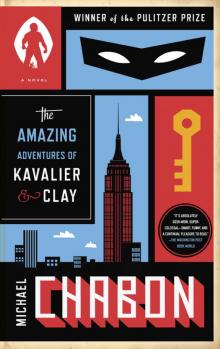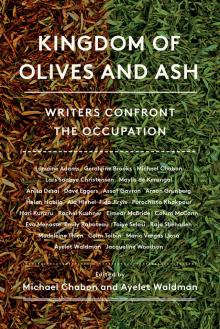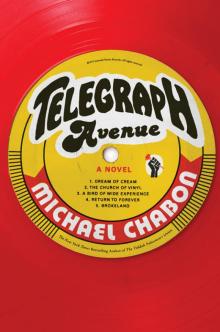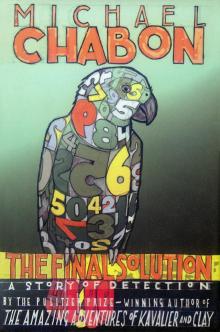- Home
- Michael Chabon
Maps and Legends Page 6
Maps and Legends Read online
Page 6
Lyra lives in a room at Jordan College, where she has led a half-feral, largely pleasurable life as the seditious, indifferently educated ward of the college, looked after by a gruff old housekeeper and a faculty of male scholars who have no idea what to make of or do with her. Her childhood, an unbroken series of small adventures, hair-raising exploits, and minor wars among the local tribes of Oxford’s children, is evoked by Pullman in the first book’s opening chapters with verve, humor, and the special poignance of his foreknowledge, and our strong suspicion, that it is Lyra’s childhood—and indeed Childhood itself—that will prove to be the irrecoverable paradise, the Dreamtime, of his story.
There is, of course, no Jordan among the colleges of Oxford University. Lyra’s Oxford exists in a different universe, one in which, as in our own, it is a primary center of learning and scholarship for England, Europe, and the world, has deep ecclesiastical roots, and sits astride the Thames River, on a bend known locally as the Isis. But in Lyra’s world, though it strongly resembles our own in many ways—including possessing what appears to be an identical geography—evolution and history have taken different bends. Here, during the Reformation, the Holy See was transferred from Rome to Geneva; at some point John Calvin became pope. Somehow this, and a number of other premises, most of which Pullman leaves unstated, form a syllogism whose conclusion is a world united under the rule of a powerfully repressive Church Triumphant that is itself fatally divided among warring factions of bishops and prelates banded into orders whose names are at once bland, grand, and horrible: the Consistorial Court of Discipline, the General Oblation Board (charged with preparing oblations, or offerings, whose nature is at first a source of considerable mystery). What we know as science, in particular physics, is viewed in Lyra’s world as a subject fit for philosophers and above all for theologians—the study of fundamental particles is known there as experimental theology. Its discoveries are subject to ultimate review by the Church, and painful is the reward awaiting those, like a certain Russian Dr. Rusakov, who posit the existence of phenomena that violate Church teaching.
Lyra’s world, with its shuffled deck of underlying premises, is technologically accomplished in ways that equal and even exceed our own—helped in this regard by its willingness to view as controllable natural phenomena what our world would call magic—and in other ways strangely retarded or perverse. Electric power is widely in use, though it is known as “anbaric power” (the terms are etymologically akin, deriving from the Greek and Arabic words for amber), produced by great river-spanning dynamos and “atom-craft” plants, but guns have no ascendancy, refrigeration and the science of food preservation appear to be unknown, and computers and automobiles are little in evidence. Instead travel proceeds on foot, by boat, or by that colophon of alternate-world fiction from Ada to The League of Extraordinary Gentlemen, the grand zeppelin liner. But for all its neo-Edwardian style, Lyra’s Oxfordshire appears largely to remain sunk in the Middle Ages—agrarian, semifeudal, reckoning its calendar by harvest and fair and by the seasonal comings and goings of a small, fierce nation of people known as Gyptians, led by their king, John Faa, whose name appears, in our world, in a well-known fifteenth-century English ballad about a gypsy king.
While Pullman alludes to Nabokov (one of the characters in The Subtle Knife voyages to Nova Zembla), his paired Oxfords stand in a very different relation from that of Ada’s Terra and Antiterra, which reflect and comment only upon each other, locked in a transdimensional self-regard which in turn mirrors that of the vain Van Veen. Instead, Pullman has consciously and overtly founded the structure of his fictional universe on the widely if not universally accepted “many-worlds hypothesis,” derived from quantum physics—in His Dark Materials there will eventually turn out to be (rather conservatively) “millions” of such worlds, though in the end Pullman has only guided us through half a dozen of them.* Lyra’s and ours are only two among the infinite number of possible Oxfords, all of which, according to the hypothesis at its most extreme, exist.
Pullman’s use of such avant-garde scientific notions as the multiverse and dark matter (more on that later) might incline one to slap the label of “science fiction” onto his work along with “epic fantasy,” “YA,” and “alternate-world fiction”; but the quantum physics in His Dark Materials is mostly employed as a rationale for the standard world-hopping that heroes and heroines of fantasy have been engaging in from Gilgamesh onward. More interesting is Pullman’s understanding of the metaphoric power of the many-worlds theory. An endlessly ramifying series of possibility-worlds, diverging and diverging again with each alteration in state, each tiny choice made, each selection of B over A: this may or may not be physics, but it is indisputably storytelling. And Pullman, as it turns out, is an unabashed concocter of stories, with a deep, pulpy fondness for plot. He is also, in the great tradition of unabashed concocters of stories, a highly self-conscious storyteller. By the end of The Amber Spyglass, one has come to see Pullman’s world-calving imagination, to see Imagination itself, as the ordering principle, if not of the universe itself, then of our ability to comprehend, to wander, and above all to love it.
* Pullman avoids use of the term “multiverse,” arguably coined by the greatest writer of post-Tolkien British fantasy, Michael Moorcock, to whose work Pullman’s is clearly indebted.
3.
However far the narrative may wander, the action of His Dark Materials centers tightly, even obsessively, on the interrelation of two of Pullman’s many felicitous inventions: daemons and Dust.
The goddess of writers was smiling upon Philip Pullman on the day he came up with the idea for daemons. These are, in Lyra’s world, the inseparable life companions of every human being. Daemons take the shapes of animals, but they have reason and the power of speech. Lyra’s is named Pantalaimon—she calls him Pan—and at first we take him to be her animal-familiar, but we soon learn that he is in fact the equivalent of what is known in our world as the soul. The bond between human and daemon is fundamental, essential, empathic, and at times telepathic. When a daemon’s human being dies, its own life ends; the daemon winks out of existence, snuffed out like a candle flame. Pan, like all children’s daemons, has not yet “settled”—that is, he can take on, at will, the shape of any animal he wishes, a power he will retain until Lyra reaches puberty. When Pan is frightened or anxious to conceal himself, he is a moth, or a mouse; when he wishes to intimidate or to repel attack, he becomes a snarling wildcat; when Lyra is feeling lonely or cold, he becomes a soft, warm ermine and drapes himself tenderly around her neck.
As the story unfolds, new wrinkles and refinements in the relationship between human and daemon keep occurring to Pullman, and he reports them to us at once with the palpable storyteller’s excitement that animates (and at times undermines) the entire series: while people generally have daemons of the opposite gender to their own, some rare oddballs have a same-sex daemon; people tend to get the daemons they deserve (schemers have snake daemons, servants have dog daemons); there is a painful limit to the distance by which a human and a daemon can stand to be separated, except in the case of the witches of the North—those Lapland witches mentioned by Milton in Book II of Paradise Lost?—who undergo a fearsome initiation rite that enables them and their daemons to travel separately. And so on. My then-eight-year-old daughter expressed what I imagine is a near-universal response of readers, young and old, to His Dark Materials (and probably the ultimate secret of the series’ success): “I wonder what kind of daemon I would have!”
When we meet them, Lyra and her daemon are spying on hastily organized preparations for the return to Jordan College of the man she believes to be her uncle, Lord Asriel, an explorer and inventor of formidable reputation. Pan has advised against this foray into the forbidden Retiring Room, and he flutters anxiously on her shoulder, having taken for the moment the fearful, flighty form of a moth. It is here, hidden in a wardrobe full of scholars’ gowns, that Lyra and we first encounter the sparkling puzzle of Dust
.
Lord Asriel has just returned from the North, where he led an expedition (lovingly outfitted by Pullman, like all the novels’ several expeditions, with the full Shackletonian panoply of late-Victorian explorers’ gear) to observe the phenomena known, after the Church-burned heretic who first described them, as Rusakov particles, or Dust. All of the novels’ villains, demagogues, and amoral researchers, as well as a number of its finer, nobler characters—Pullman, true to his YA roots, has a tendency to lay on the fine and the noble with a rather heavy spackling knife—believe, or come to believe, that the continued existence of the theocratic, Church-determined, hierarchical universe as they know it depends on understanding the mysterious charged particles known in our world as dark matter and in Lyra’s as Dust. These invisible particles seem to be connected in some way to the aurora borealis,† and they have the curious property (as Lord Asriel proceeds to demonstrate by means of a photographic process of his own invention, with Lyra and Pan, concealed in the wardrobe, hanging on his every word) of being powerfully attracted to adult human beings, settling on them like dander or snow, while appearing to be completely uninterested, if particles can be said to take interest (and they can!), in children.
Lord Asriel has returned from the North to hit up the College for more funding, ostensibly so that he can continue his purely scientific research into the puzzling nature of Dust. In reality he intends to follow the trail of falling Dust out of Lyra and her daemon’s world and into another. He doesn’t mention this, however, or that implementing his plan of opening a breach through the boreal “thin patch” will require the sacrifice of a child by means of a horrific brand of metaphysical vivisection known as “intercision.”
Intercision is also the business of the General Oblation Board, an arm of the Church that has recently begun a spectacular rise to power under the direction of Mrs. Coulter, its lay chairman. Mrs. Coulter is, until she receives an unfortunate first name (the far too British Vogue “Marisa”) and, even more unfortunately, a heart, somewhere around the second quarter of The Amber Spyglass, one of the great villains of recent popular literature, right up there, in viciousness, strength, intelligence, and inexorableness, with Lonesome Dove’s (unredeemed to the end) Blue Duck. Mrs. Coulter, beautiful, elegant, capable of simulating terrible charm and warmth, her natural mode a fittingly polar coldness, accompanied everywhere by her truly scary golden monkey daemon, has the power, like all good femmes fatales, to cloud men’s minds.
Under her spell, and frightened by the implications of Dust’s evident attraction to experience in the Blakean sense, to Fallenness—believing that Dust may be the physical manifestation of Original Sin itself—the Church leadership has authorized Mrs. Coulter to lead a northern expedition of her own, one that will seek to determine whether Dust—Sin—can be forestalled, fended off, or eliminated entirely, by the intercision of a child before his or her daemon has “settled.” Naturally this course of research, carried out at a remote post in the Arctic, where Dust streams most plentifully, requires a steady supply of preadolescent subjects. Under Mrs. Coulter’s orders, teams of child-snatchers—known semimythically among the local children as “Gobblers”—fan out across England, baiting their traps with sweets and kindness. When her best friend at the College, a servant’s child named Roger, is stolen away by Mrs. Coulter’s General Oblation Board, Lyra determines to set off for the North and save him.
The first volume of the sequence, The Golden Compass, is taken up with the competing schemes of Lord Asriel and Mrs. Coulter to understand and if possible control Dust, and with Lyra’s quest to find Roger and at the same time to convey to Lord Asriel (funded again and back in the North) a marvelous contraption called an alethiometer. The alethiometer is Pullman’s third great invention, after daemons and Dust. A beautiful instrument of gold and crystal, engraved with an alphabet or tarot of conventional symbols and fitted with knurls and indicator needles, the alethiometer will answer any question put to it, though it will not predict the future. When it comes to reading the alethiometer, a skill that normally demands a lifetime of training and study, Lyra proves to be a natural.
Under the alethiometer’s tutelage, and with the help of a troop of stout Gyptians, Lyra makes her way north, learning, in the usual way of such journeys, even more about herself and her history than about the world she lives in, and discovering that there is a prophecy among the witches that she seems to be about to fulfill. Along the way she encounters an adventurer named Lee Scoresby, a Texan from New Denmark (her world’s U.S.), who comes equipped with a hot-air balloon and a greasepaint-Texan manner that will be familiar to readers of Buchan and Conan Doyle; and the appealing Iorek Byrnison, who in spite of his Nordic name is a polar bear, or a kind of polar bear, polar bears in Lyra’s world having evolved opposable thumbs (they are mighty smiths) and the power of speech. Interestingly it is Byrnison the bear and not Scoresby the Texan who plays the Lee Marvin role in this novel, rousing himself from an alcoholic miasma of failure—it all turns on a question of bear politics—through admiration of the gifted and fiery girl.
With the help of her companions, and following a number of hectic battles and one chilling scene of paternal anagnorisis (moment of recognition), Lyra fulfills her pledge to deliver the alethiometer to Lord Asriel and rescue Roger and the other stolen children—though with results that she finds, in the former instance, disappointing (Lord Asriel is stricken with a weird horror when he recognizes Lyra at the door of his polar fortress of solitude) and, in the latter, unexpectedly tragic, as poor Roger provides the means for Lord Asriel’s breaching of the border between worlds.
The second volume, The Subtle Knife, introduces a new character, one who will come to assume an equal stature in the series to Lyra’s. He is Will Parry, a boy of roughly Lyra’s age who lives in a drab suburb near Oxford—our Oxford, this time. When we meet him, Will is struggling to protect himself and his mother—his father, an explorer and former Royal Marine, disappeared years before—from some sinister men, vaguely governmental, who are after the letters that Mr. Parry sent back home from the Arctic just before his disappearance. It’s a struggle for Will because his mother is no help at all; she’s mad, affected by some kind of obsessive-compulsive disorder that leaves her barely functional as a human being, let alone as a mother. For years, young Will has been handling all the duties and chores that his mother can’t manage, and caring for her on her bad days, working very hard to maintain the illusion that all is well in the Parry house. He doesn’t want them to come and take his mother away from him.
When the government agents grow overbold and confront his mother directly, Will realizes that his life is about to change. There is a poignant scene in which, seeking out the only kind, trustworthy person he has ever known—he has no friends—he leaves his bewildered mother with a nearly equally bewildered older woman who was once, briefly, his piano teacher, Mrs. Cooper (the name alludes to Susan Cooper, author of the beloved The Dark Is Rising sequence of novels, whose central protagonist is a boy named Will). Then he finds and collects his father’s letters, accidentally killing one of the government men in the process, and flees.
He flees—though this is not, of course, his intention at first—into another world, to a place called Cittàgazze, the City of the Magpies. For it turns out that there are other ways to pass among the worlds than by Lord Asriel’s costly method of child-sacrifice and transdimensional demolition. One can, if properly equipped, simply cut a hole in the membrane that separates realities from each other. To do this one needs a knife—a very special kind of knife, naturally: a subtle knife. There is only one of these in all the worlds; it was forged, some three hundred years ago, by the savants of the Torre degli Angeli, a kind of scientific academy housed in a castellated tower’in Cittàgazze. They forged it; and then, unfortunately, they began to use it, cutting their way from world to world, leaving a trail of carelessly abandoned holes such as the one through which Will, fleeing the murder he has committed, tumbles.
> In the desolate, De Chirico streets of Cittàgazze, Will Parry meets Lyra; she has come from her world through the breach Lord Asriel created, hoping to solve the riddle of Dust, intuiting that contrary to the teachings of the Church, it may in fact be a blessing and not a curse. Lyra is at first as startled to see a living, thriving boy with no daemon as Will is to watch her pet cat transform itself into a stoat. But the two children, alone in a world of wild menacing orphans (all the adults here having fled or been devoured), form a bond and make common cause: Will, following hints in John Parry’s letters, intends to track his father down. And Lyra, taking instruction from the alethiometer, determines to help him. In an exciting scene Will inherits the subtle knife, and away the two children go, in search of John Parry and the riddle of Dust.
They are far from alone in these pursuits; a host of adult characters—Lee Scoresby, Iorek Byrnison, Mrs. Coulter, Lord Asriel, the witch Serafina Pekkala, a nun turned theoretical physicist of our world named Mary Malone—follow courses that parallel, intersect, or shadow Will and Lyra’s. The Golden Compass is Lyra’s book, structured around her and presented almost wholly through her point of view, and as such it reads very much like a traditional quest story. The Subtle Knife, with its shifting points of view and its frequent presentation of adult perspectives on Lyra and Will, has much more the flavor of a thriller. It is unflaggingly inventive, chilling, and persuasive, has a number of gripping action sequences, and ends with a thrilling zeppelin battle in the Himalayas. But something—the pleasure inherent, perhaps, in the narrative unfolding of a single consciousness—is lost in the transition from first volume to second; and though Pullman’s storytelling gifts reach their peak in The Subtle Knife, the sequence itself never quite recovers from this loss.

 McSweeney's Mammoth Treasury of Thrilling Tales
McSweeney's Mammoth Treasury of Thrilling Tales The Amazing Adventures of Kavalier & Clay
The Amazing Adventures of Kavalier & Clay The Yiddish Policemen's Union
The Yiddish Policemen's Union Wonder Boys
Wonder Boys Manhood for Amateurs
Manhood for Amateurs Kingdom of Olives and Ash: Writers Confront the Occupation
Kingdom of Olives and Ash: Writers Confront the Occupation Gentlemen of the Road: A Tale of Adventure
Gentlemen of the Road: A Tale of Adventure A Model World and Other Stories
A Model World and Other Stories Pops: Fatherhood in Pieces
Pops: Fatherhood in Pieces McSweeney's Enchanted Chamber of Astonishing Stories
McSweeney's Enchanted Chamber of Astonishing Stories Summerland
Summerland Telegraph Avenue
Telegraph Avenue The Final Solution
The Final Solution The Mysteries of Pittsburgh
The Mysteries of Pittsburgh Werewolves in Their Youth
Werewolves in Their Youth Bookends
Bookends Fight of the Century
Fight of the Century Maps and Legends
Maps and Legends The Amazing Adventures of Kavalier & Clay (with bonus content)
The Amazing Adventures of Kavalier & Clay (with bonus content) Kingdom of Olives and Ash
Kingdom of Olives and Ash Pops
Pops Gentlemen of the Road
Gentlemen of the Road The Final Solution: A Story of Detection
The Final Solution: A Story of Detection Telegraph Avenue: A Novel
Telegraph Avenue: A Novel